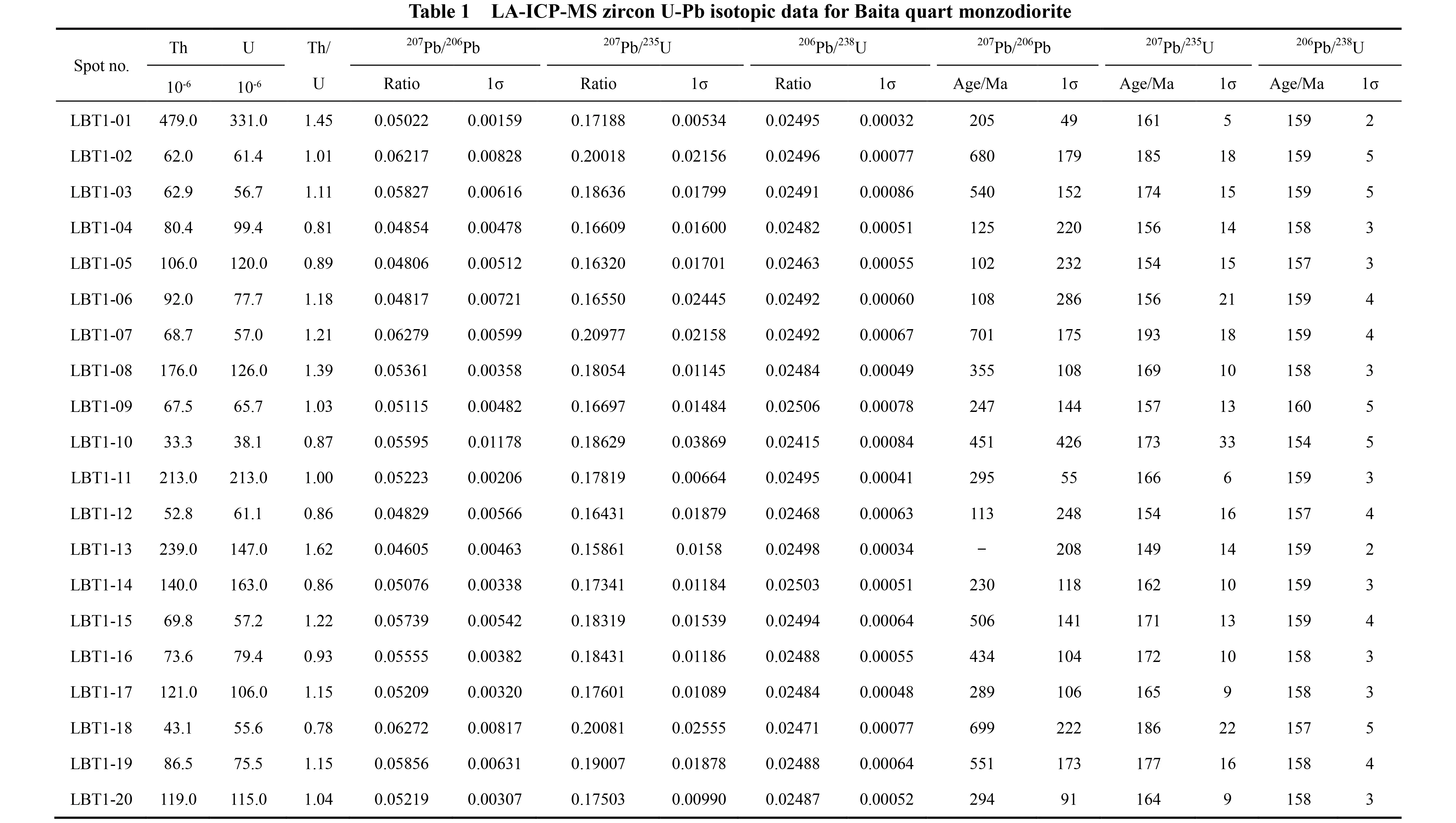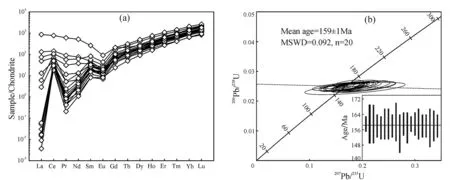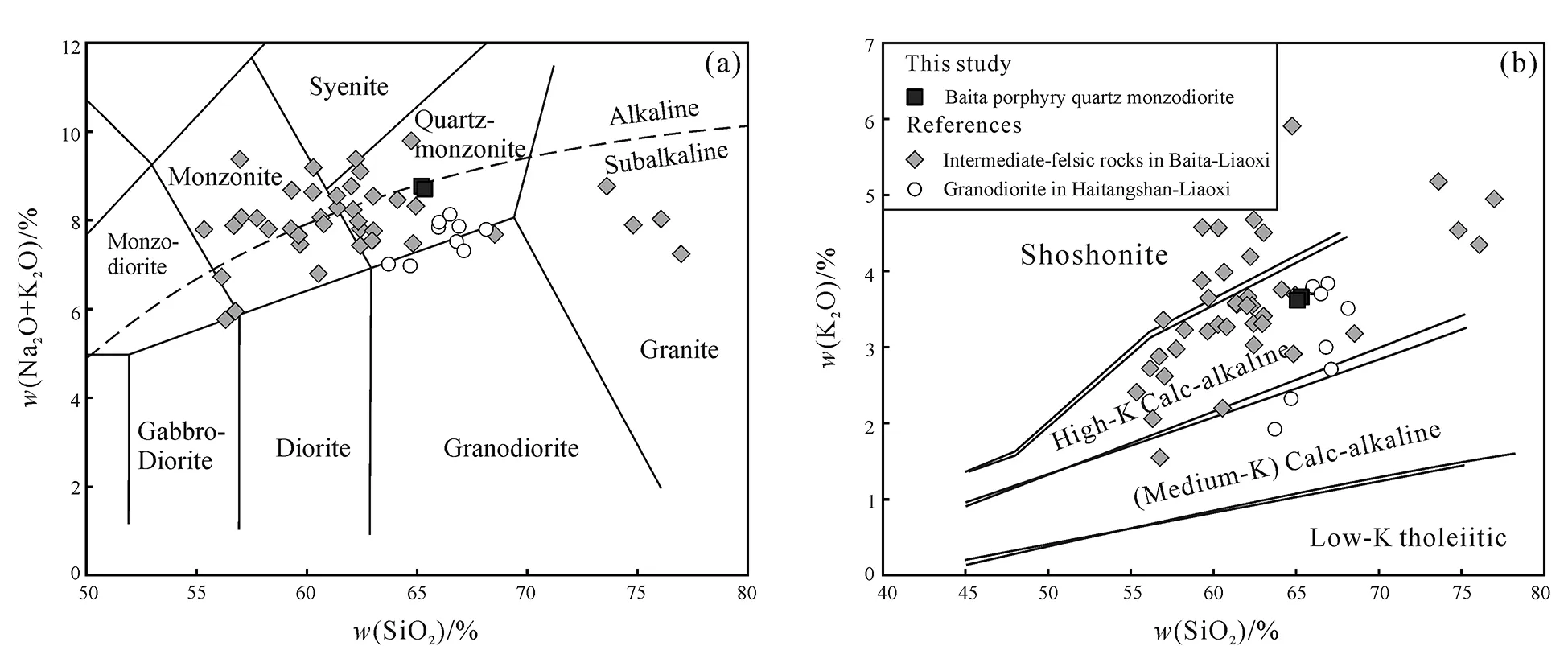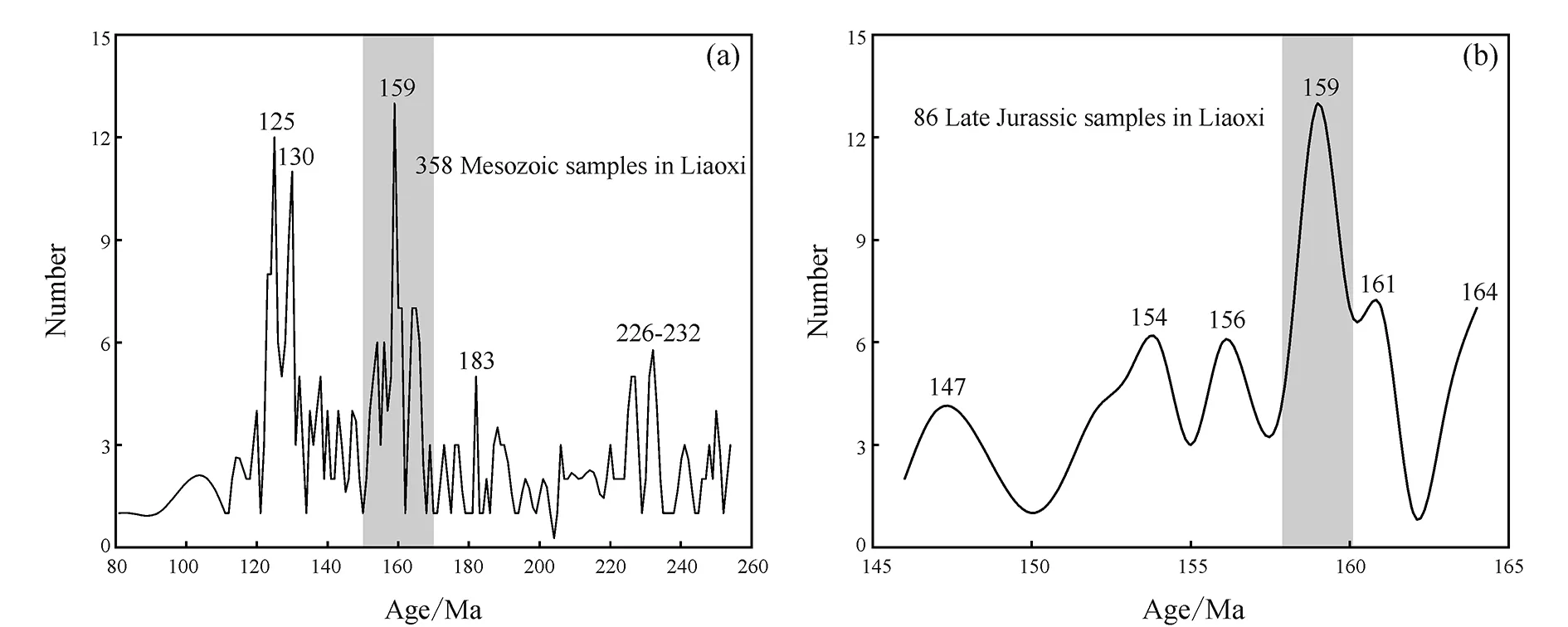U-Pb-Hf isotopes and petrogenesis of Late Jurassic akakitic quartz monzodiorite in Xingcheng area, western Liaoning Province
2021-09-10YANXiangyuYANGDebinMUMaosongandHAOLeran
YAN Xiangyu, YANG Debin, MU Maosong and HAO Leran
College of Earth Sciences, Jilin University, Changchun 130061, China
Abstract: The petrogenesis and geodynamic setting of the Late Jurassic Baita porphyry quartz monzodiorite in Xingcheng--Liaoxi area provide information for understanding the Mesozoic tectonic evolution of the northeastern North China Craton. In this paper, geochronological, whole-rock geochemical, and in-situ zircon Hf isotopic analyses of Baita porphyry quartz monzodiorite were investigated to constrain the crystallization age and petrogenesis. Zircons exhibit typical oscillatory zoning in cathodoluminescence images and show relatively high Th/U ratios (0.78--1.62), and U-Pb analyses indicate that these rocks were crystallized during the Late Jurassic (159±1 Ma). Geochemically, they are characterized by high contents of SiO2 (65.21wt%--65.31wt%), Al2O3 (16.29wt%--16.31wt%), Sr (521×10-6-539×10-6), and Sr/Y ratio (45.1--47.8) but low Y (10.9×10-6-12.0×10-6), with obvious adakitic geochemical affinities. These above-mentioned findings, combined with their negative εHf(t) values (-21.7 to -20.2), corresponding two-stage model age (TDM2) of 2 579--2 484 Ma, as well as low MgO (1.38wt%--1.39wt%), Cr (18.5×10-6-19.5×10-6) and Ni (9.45×10-6-9.46×10-6) values, indicate that Baita porphyry quartz monzodiorite may be generated by partial melting of the Neoarchean-Paleoproterozoic thickened basaltic lower crust. Based on the results from this study and pre-vious regional studies, it is concluded that Baita porphyry quartz monzodiorite was spatially related to the westward subduction of the Paleo-Pacific plate.
Keywords: Liaoxi; Late Jurassic; adakitic rocks; thickened lower crust; Paleo-Pacific plate
1 Introduction
Defant and Drummond (1990) were the first to define the term of adakites, in order to describe Cenozoic arc magmas documented in Adak Island produced by partial melting of the subducted young (≤25 Ma) oceanic slab. However, further studies found that some rocks with adakitic geochemical characteristics are clearly unconnected to oceanic-slab melting (henceforth called adakitic rocks) (Xuetal., 2002; Castillo, 2006). Current studies have shown that adakitic rocks are produced roughly through three petrogenesis models: partial melting of the thickened lower crust (Castillo, 2006, 2012; Wangetal., 2006; Yangetal., 2016), assimilation-fractional crystallization (AFC) processes involving a basaltic magma (Castilloetal., 1999; Macphersonetal., 2005; Castillo, 2006, 2012; Xuetal., 2006), and partial melting of the delaminated lower continental crust (Xuetal., 2002; Gaoetal., 2004; Wangetal., 2005; Castillo, 2006, 2012; Xuetal., 2006; Yangetal., 2008a). Also, it was believed that adakitic rocks commonly occurred in an arc setting (Defant & Drummond, 1990; Castilloetal., 1999; Castillo, 2006), but recently, some studies proposed that some adakitic rocks were also formed in non-arc tectonic environments, e.g., intra-continental extension (Castillo, 2006, 2012; Wangetal., 2006). Therefore, investigating petrogenesis and geodynamic evolution of adakitic rocks is beneficial to the understanding of continental lithosphere evolution and its formation process.
The Baita plutonic rock is located in the Yan-shan--Liaoxi area, northeastern North China Craton (NCC). Numerous studies on high precision dating of Mesozoic intermediate-felsic rocks have been carried out in this area (Wuetal., 2006; Yangetal., 2006, 2008b; Yang, 2007; Sunetal., 2010; Lietal., 2014; Zhangetal., 2014a; Zhang, 2014; Cui, 2015; Chenetal., 2016; Lin, 2017; Songetal., 2018; Cuietal., 2020; Hu, 2020), and the results show that most rocks were emplaced in the Middle--Late Jurassic and originated from partial melting of the ancient crust (Lietal., 2014; Zhangetal., 2014a; Cui, 2015; Chenetal., 2016; Songetal., 2018; Cuietal., 2020). Although several studies have previously reported their results on geochronology and geochemistry (Cui, 2015; Lin, 2017; Songetal., 2018; Cuietal., 2020), there is still controversy concerning the wide range of dating results and the petrogenesis of Baita intermediate-felsic rocks. According to the contact relationship in the field, the Baita rock mass was regarded as an Indosinian intrusive rock (LBGMR, 1989). However, Cui (2015) reported LA-ICP-MS zircon U-Pb age of Baita quartz diorite of 156 Ma, and they were derived from partial melting of the ancient middle-upper crust. As for the Middle--Late Jurassic volcanic rocks in the Baita area, Lin (2017) and Songetal. (2018) supposed that the Baita volcanic rock was emplaced during the Middle--Late Jurassic, mainly derived from partial melting of the thickened lower crust.
In this study, the authors carried out a detailed geochronological, geochemical and in-situ zircon Hf isotopic investigation of the Late Mesozoic Baita porphyry quartz monzodiorite in the Xingcheng--Liaoxi area, northeastern NCC, to reveal their age, petrogenesis and tectonic setting, which could provide bene-ficial evidence to the understanding of tectonic evolution of the northeastern NCC during the Late Mesozoic.
2 Geological background and petrography
The NCC is an old and stable carton in the world (Jahnetal., 1988; Zhaoetal., 2001, 2005), and bounded by the Central Asian Orogenic Belt (CAOB) in the north, the Dabie--Sulu ultrahigh-pressure collisional belt in the south (Wuetal., 2005, 2006; Yangetal., 2006, 2008b), which is generally divi-ded into the Western Block, the Eastern Block and the Trans-North China Orogen (Zhaoetal., 2001; Fig.1a). However, during the Mesozoic, the NCC experienced extensive and intensive tectonic-magmatism (Xuetal., 2002), closely related to the westward subduction of the Paleo-Pacific plate (Wuetal., 2005, 2006; Yangetal., 2006, 2008b).
The study area is tectonically situated in the Liao-xi block, northeastern NCC. In addition, the Liaoxi block consists of Early Archean--Paleoproterozoic basement overlain by, or locally in fault contact with Mesoproterozoic-Cenozoic sedimentary sequences, which are intruded by Proterozoic--Mesozoic intrusive plutons (Yangetal., 2006, 2008b; Xuetal., 2019). Besides, almost all periods of Mesozoic magmatism in the eastern NCC can be found in the Liaoxi area (Wuetal., 2006; Yangetal., 2006, 2008b; Sunetal., 2010; Lietal., 2014; Zhangetal., 2014a; Cui, 2015; Chenetal., 2016; Songetal., 2018; Cuietal., 2020), and it is also one of the most important areas to study the NCC Mesozoic magmatism (Wuetal., 2006; Zhangetal., 2014b). With abundant high-precision zircon SHRIMP and LA-ICP-MS U-Pb as well as40Ar-39Ar ages, Mesozoic magmatism in Liaoxi area could be divided into three periods: Late Triassic (Wuetal., 2006; Yangetal., 2006; Zhangetal., 2014b; Cui, 2015), Middle--Late Jurassic (Wuetal., 2006; Yangetal., 2006; Yang & Li., 2008; Sunetal., 2010; Zhangetal., 2014a; Cui, 2015; Liangetal., 2015; Cuietal., 2020), and Early Cretaceous (Wuetal., 2006; Yangetal., 2006, 2008b; Yang & Li., 2008; Cui, 2015; Cuietal., 2020), respectively, of which the Middle--Late Jurassic magmatism is most intensive, with main age peaks of 166 Ma, 159--161 Ma and 152 Ma (Wuetal., 2006; Zhangetal., 2014b).

Fig.1 (a) Simplified main tectonic subdivisions (after Zhao et al., 2005) and (b) a simplified geological map (after LBGMR, 1989)
The Baita area predominantly consists of Jurassic intrusive/volcanic rocks (Cui, 2015; Lin, 2017; Songetal., 2018; Cuietal., 2020), coupled with Early Cretaceous Yixian Formation and Cenozoic sediment (Fig.1b). The Baita plutonic rocks are predo-minantly comprised of monzogranite and quartz diorite as well as porphyry quartz monzodiorite, which is mainly exposed as a stock and/or dyke striking approximately NE-NNE (Cuietal., 2020). Baita porphyry quartz monzodiorite (LBT-1; N 40°40′50″, E 120°36′45″) was collected from fresh outcrops, gray-white in color, with medium- to coarse-grained porphyritic texture and massive structure. The phenocryst mainly comprises plagioclase (Fig.2a, b), and main minerals include quartz (15%--20%), plagioclase (60%--65%), and orthoclase (15%--20%), with minor biotite (3%--5%). Accessory minerals include zircon, magnetite and apatite (Fig.2c, d).
3 Analytical results
3.1 Zircon U-Pb geochronology
The results of zircon U-Pb analyses from Baita porphyry quartz monzodiorite (sample LBT-1) are listed in Table 1. Most zircon grains are generally colorless and transparent, euhedral to subhedral in the cathodoluminescence (CL) image (Fig.3). In addition, they are prismatic with lengths of 100--200 μm and display a clear oscillatory zoning structure (Solid line and dashed circles on zircons show the location of U-Pb analyses (spot size of 32 μm) and the Hf analyses (spot size of 44 μm), respectively). Besides, both the rare earth element (REE) patterns and Th/U ratios (0.78--1.62) of analyzed zircons suggest a magmatic zircon origin (Fig.4a). All analytic zircon grains from sample LBT-1 form a single concordant206Pb/238U age populations from 154± 5--160±5 Ma and yield a weighted mean206Pb/238U age of 159±1 Ma (MSWD=0.092, Fig.4b).

Bi-biotite; Pl-plagioclase; Or-orthoclase; Q-quartz.Fig.2 Representative field photograph (a) and thin-section photographs (b-d)

Fig.3 Cathodoluminescence (CL) images


Fig.4 Chondrite-normalized rare earth element patterns (a) and zircon LA-ICP-MS U-Pb concordia diagrams (b)
3.2 Whole-rock geochemical characteristics
The results of whole-rock major- and trace element analyses for two samples of Baita porphyry quartz monzodiorite are given in Table 2 and illustrated in Fig.5, 6. Two samples exhibit relatively high SiO2(65.21wt%--65.31wt%), K2O (3.66wt%--3.77wt%) and uniform Na2O (5.11wt%) contents, but low MgO (1.38wt%--1.39wt%) values. As shown on the (Na2O + K2O) versus SiO2diagram (Irvine & Baragar, 1971), all samples display sub-alkaline affinities, and mainly fall in the quartz mon-zonite field (Fig.5a). In addition, they also possess high Na2O/K2O ratios (1.39--1.40) and Na2O+K2O contents (8.77wt%--8.78wt%), and exhibit the high-K calc-alkaline character in the K2O versus SiO2plot (Peccerillo & Taylor, 1976; Fig.5b), similar to regional Yingchangkou--Baita quartz diorite and Baita--Jiashan volcanic rocks (Cui, 2015; Lin, 2017; Songetal., 2018). Moreover, these rocks are also characterized by relatively high Al2O3(16.29wt%--16.31wt%), uniform TFe2O3(4.43wt%) and TiO2(0.58wt%) values, but low CaO (1.02wt%--1.03wt%), Cr (18.5×10-6-19.5×10-6), Co (8.89×10-6-9.07×10-6) and Ni (9.45×10-6-9.56×10-6) concentrations.

Fig.5 Na2O+K2O vs SiO2 diagram (a) (after Irvine & Baragar, 1971) and K2O vs. SiO2 diagram (b) (after Peccerillo & Taylor, 1976)

Fig.6 Chondrite-normalized REE patterns (a) and primitive mantle-normalized trace element spidergrams (b) (after Sun & McDonough, 1989)

Table 2 Whole-rock major (wt%) and trace element (10-6) data of Baita porphyry quartz monzodiorite
Samples from Baita porphyry quartz monzodiorite exhibit slightly enrichment of LREE relative to the HREE in the chondrite-normalized rare earth element (REE) patterns (Fig.5a), with high (La/Yb)Nratios (15.31--15.94), and slightly negative Eu anomalies (Eu/Eu*= 0.78--0.79; Table 2). In the primitive mantle-normalized diagram (Fig.5b), they display remarkable enrichment in large-ion lithophile elements (LILEs, such as Rb, Ba, Pb and Sr), and depletion in high field strength elements (HFSEs, such as Nb, Ta, P and Ti). Besides, because of high Sr (521×10-6-539×10-6) and La (28.6×10-6-29.4×10-6) concentrations, and low Y (10.9×10-6-12.0×10-6) and Yb (1.21×10-6-1.29×10-6) contents, coupled with high Sr/Y (45.1--47.8) and La/Yb (15.3--15.9) ratios, all samples mostly fall within the adakites field on the Sr/Y-Y diagram (Fig.7a), similar to regional Yingchangkou--Baita quartz diorite and Jiashan--Baita volcanic rocks (Cui, 2015; Lin, 2017; Songetal., 2018).

Fig.7 Zircon εHf(t) vs. age diagram (a) (after Zhang et al, 2011) and TDM2 (Ma) probability diagram (b)
3.3 In-situ zircon Hf isotopes
In-situ zircon Hf isotopic compositions were determined for seven samples and the analytic results are listed in Table 3. They show relatively homogeneous Hf isotopic compositions, with initial176Hf/177Hf ratios of 0.282 065--0.282 165, εHf(t) values of -21.7 to -20.2, and corresponding two-stage model age (TDM2) of 2 579--2 484 Ma. Samples from Baita porphyry quartz monzodiorite plot between the mafic crust and average crust on the εHf(t) versus Age diagram (Fig.7a; Zhangetal., 2011), consistent with the Middle--Late intermediate-felsic rocks in the Baita--Liaoxi area (Zhangetal., 2014a; Cui, 2015, Lin, 2017; Songetal., 2018).

Table 3 Zircon Hf isotopic compositions of Baita quartz monzodiorite
4 Discussion
4.1 Age of Baita porphyry quartz monzodiorite in Xingcheng--Liaoxi area
In this paper, zircons U-Pb data from Baita porphyry quartz monzodiorite yield concordant206Pb/238U age populations of 154±5--160±5 Ma, with a weighted mean206Pb/238U age of 159±1 Ma (MSWD=0.092, n=20; Fig.4b). Due to relatively high Th/U ratios (0.78--1.62), and clear oscillatory zoning in the CL image of the samples (Fig.3), this age could be interpreted to represent the crystallization age of Baita porphyry quartz monzodiorite, roughly consistent with Yingchangkou--Baita quartz diorite (157--156 Ma; Cui, 2015), and coevally adjacent Baita--Jiashan volcanic rocks (165--149 Ma; Lin, 2017; Songetal., 2018). In addition, this crystallized age was also similar to voluminous contemporaneous intermediate-felsic rocks in the Yanshan--Liaoxi area, such as Jianchang--Yangjiazhangzi batholiths (160--150 Ma; Wuetal., 2006) and Haitangshan--Yiwulyushan batholiths (170--150 Ma; Wuetal., 2006; Zhangetal., 2014a). Besides, Yang & Li (2008) determined the age of the Lanqi Formation (166--153 Ma) volcanic rocks with40Ar-39Ar and zircon U-Pb dating, which was also crystallized in the Late Jurassic. Moreover, this magmatic event is similar to Middle--Late Jurassic intermediate-felsic rocks in the Liaodong Peninsula (Wuetal., 2005). Accordingly, Baita porphyry quartz monzodiorite was crystallized during the Late Jurassic.
The Mesozoic granitoids were extensively distri-buted in many localities of the Yanshan--Liaoxi area, which were traditionally considered having crystallized mainly in the Indosinian period. However, precise geochronological studies have been reported in the past few years, and these zircon U-Pb dating analyses are different from previous views and they are products of the Yanshanian magmatism (Wuetal., 2006; Yangetal., 2006, 2008b; Zhangetal., 2014a; Cui, 2015; Lin, 2017; Songetal., 2018). The Mesozoic magmatism in the Yanshan--Liaoxi area could be do-minantly divided into two stages: Late Jurassic and Early Cretaceous (Fig.8a; Wuetal., 2006; Yangetal., 2006; Sunetal., 2010; Zhangetal., 2014a, 2014b; Cui, 2015; Lin, 2017; Songetal., 2018). Besides, the Early Cretaceous magmatism displays major age peaks of 125 Ma (Fig.8a; Yang, 2007; Lietal., 2014; Zhangetal., 2014a, 2014b, 2014c; Cui, 2015; Zhang, 2016; Lin, 2017; Songetal., 2018; Hu, 2020), while the Late Jurassic magmatism shows main age peaks of 159 Ma, similar to the crystallization age of Baita porphyry quartz monzodiorite (Fig.8b). Therefore, a long-lived Late Jurassic magmatic event is a major period of the Mesozoic magmatism in the Yanshan--Liaoxi area.

Fig.8 Age probability diagram
4.2 Petrogenesis of Baita porphyry quartz monzodiorite
Baita porphyry quartz monzodiorite possesses relatively high SiO2(65.21wt%--65.31wt%), Al2O3(16.29wt%--16.31wt%), K2O (3.66wt%--3.67wt%) and Na2O (5.10wt%) contents, but low TFe2O3(4.43wt%) and MgO (1.38wt%) values, precluding a mantle origin, since primitive mantle melt have relatively low SiO2(45.0wt%) with high TFe2O3(7.29wt%) and MgO (37.8wt%) values (Hart & Zindler, 1986; McDonough & Sun, 1995). By contrast, these rocks are most likely originated from the continental crust, further supported by trace-element characteristics, such as enrichment in LILEs and LREEs, but depletion in HFSEs and HREEs. Coupled with low Cr (18.5×10-6-19.5×10-6) and Ni (9.45×10-6-9.46×10-6) concentrations, these are obvious crust-like signature. Moreover, they exhibit relatively low εHf(t) values (-21.7 to -20.2; Table 3), and corresponding two-stage model age (TDM2) (2 579--2 484 Ma; Table 3). All analyzed spots plot between the mafic crust and average crust (Fig.7a), and mainly possesses two-stage model age (TDM2) from 2 600--2 400 Ma (Cui, 2015; Lin, 2017; Songetal., 2018), and 2 300--2 100 Ma (Fig.7b; Zhangetal., 2014a). Also, these Middle--Late intermediate-felsic rocks in the Baita--Liaoxi area were regarded as the products of partial melting of Neoarchean to Paleoproterozoic lower crust (Zhangetal., 2014a; Lin, 2017; Songetal., 2018). Besides, the Upper Jurassic Lanqi Formation (160±3 Ma) with andesitic breccia lava was considered being derived from partial melting of the Neoarchean basaltic lower crust (Ma & Zheng, 2009). Furthermore, this crust-like characteristic is also similar to most of the Middle--Late Jurassic magmatic rocks in the eastern NCC which exhibit ancient crust-derived isotopic features (Zhangetal., 2014b; Wuetal., 2019). Accordingly, Baita porphyry quartz monzodiorite should be originated from partial melting of the Neoarchean to Paleoproterozoic crust.
Adakites are commonly characterized by relatively high SiO2(≥ 56 wt%), Al2O3(≥ 15 wt%), and Sr (rarely < 400 × 10-6) values, but low MgO (< 3wt%), Y and HREEs (Y and Yb ≤ 18 × 10-6and 1.9 × 10-6, respectively) as well as low HFSEs contents, and absent or positive Eu anomalies (Defant & Drummond, 1990). In this study, Baita porphyry quartz monzodiorite possesses relatively high SiO2(65.21wt%--65.31wt%), Al2O3(16.29wt%--16.31wt%), Sr (521×10-6-539×10-6), but low MgO (1.38wt%), Y (10.9×10-6-12.0×10-6) and Yb (1.21×10-6-1.29×10-6) concentrations, depletion in HFSEs and absent Eu anomalies, exhibiting geochemical affinity with adakites. In addition, combined with high Sr/Y (45.09--47.80) and (La/Yb)N(15.31--15.94) ratios, these rocks mostly fall within the adakites field on the Sr/Y-Y diagram (Fig.9a; Defant & Drummond, 1990; Castilloetal., 1999), geochemically similar to adakites. This conclusion is identical to the Late Jurassic intermediate-felsic rocks in the Baita--Liaoxi district (Zhangetal., 2014a; Lin, 2017; Songetal., 2018), and also consistent with most of the Middle--Late Jurassic magma-tic rocks in the eastern NCC which exhibit adakite-like geochemical signatures (Zhangetal., 2014b; Wuetal., 2019).
Therefore, how was Baita adakitic quartz monzodiorite generated? Adakites could be generally produced by partial melting of the subducted oceanic-slab (Defant & Drummond, 1990), partial melting of the delaminated lower crust (Xuetal., 2002; Gaoetal., 2004; Wangetal., 2005; Xuetal., 2006; Yangetal., 2008a), partial melting of the thickened lower crust (Castillo, 2006; Wangetal., 2006; Yangetal., 2016), and assimilation-fractional crystallization (AFC) processes involving a basaltic magma (Castilloetal., 1999; Macphersonetal., 2005; Castillo, 2006, 2012; Xuetal., 2006).
Firstly, both samples in this study, and intermediate-felsic in the Baita--Liaoxi area, have negative εHf(t) values (-21.7 to -20.2), whereas melts from juvenile oceanic-slab generally show positive εHf(t) values (Defant & Drummond, 1990), so a subducted-slab origin is excluded. Also, there was rarely occurrence of adakitic rocks generated by partial melting of the subducted oceanic-slab during the Late Jurassic in the Yanshan--Liaoxi area (Wuetal., 2019). As a result, Baita porphyry quartz monzodiorite could not be originated from partial melting of the subducted oceanic-slab.

Fig.9 Diagrams of Sr/Y vs. Y (a) (after Defant & Drummond, 1990) and MgO vs. SiO2 (b) (after Xu et al., 2002)
In addition, these rocks display relatively high SiO2(65.21wt%--65.31wt%) that could not be directly produced by partial melting of the mantle (Wangetal., 2005). Moreover, during the Late Jurassic, large-scale co-existing basaltic rocks closely associated with Baita intrusive rocks and adjacent intermediate-felsic intrusive rocks have rarely been found in the study area. Also, the absence of apparent Eu negative anomalies in these rocks also does not favor an AFC process involving a basaltic magma (Fig.6c; Castilloetal., 1999; Xuetal., 2006; Yangetal., 2016).
Therefore, the best scenario that could explain the low MgO, TiO2, Cr and Ni content of Baita porphyry quartz monzodiorite seems to be partial melting of the thickened lower crust rather than partial melting of the delamination lower crust (Xuetal., 2002), since the melts from the delaminated lower crust gene-rally interact with overlying mantle peridotites, which commonly form high-Mg#and high Ti adakitic rocks (Castilloetal., 1999; Xuetal., 2006; Zhangetal., 2014a). Besides, in the plot of MgO versus SiO2(Xuetal., 2002; Wangetal., 2006), all samples, mainly plot in the thick lower crust-derived adakitic rocks field (Fig.9b), similar to the Late Jurassic intermediate-felsic rocks in the Baita--Liaoxi area (Zhangetal., 2014a; Lin, 2017; Songetal., 2018). Hence, Baita porphyry quartz monzodiorite with adakitic signatures was most probably the product of partial melting of the thickened mafic lower crust.
4.3 Tectonic implications
Adakites are generally connected to oceanic-slab melting in a subduction setting (Defant & Drummond, 1990; Castilloetal., 1999; Wangetal., 2005; Castillo, 2006), but later studies have also proposed that many adakitic magmas may be generated in non-arc tectonic environments unrelated to the subduction of oceanic crust (Castillo, 2006, 2012), like the intra-continental extensional setting (Wangetal., 2005, 2006). Therefore, it is still controversial for Baita porphyry quartz monzodiorite to discuss what triggered the partial melting of the lower crust.
The coexistence of typical bimodal igneous rock associations in the Liaoxi area was previously identified, including Baita porphyry quartz monzodiorite (ca. 159 Ma), and Liaoxi intermediate-felsic rocks (177--149 Ma; Wuetal., 2006; Lin, 2017; Yang & Li, 2008; Zhangetal., 2014a; Songetal., 2018; Cuietal., 2020), and Liaoxi mafic rocks (173--156 Ma; Zhangetal., 2010; Fanetal., 2017; Wanetal., 2019), as well as Xinglonggou high-Mg adakitic rocks (ca. 159 Ma; Gaoetal., 2004). These phenomena suggest that both mantle materials upwelling and remelting of ancient crust had already occurred in the Liaoxi domain for the Middle--Late Jurassic. In this paper, mantle-derived materials underplated into the thickened mafic lower crust and melted, subsequently intruded upward and formed Baita porphyry quartz monzodiorite, which is identical to contemporaneous large-scale adakitic rocks in the Liaoxi area (Lin, 2017; Songetal., 2018). In addition, Baita porphyry quartz monzodiorite also displays high Nb, Y and Rb, but low Ta contents, mainly plotting in the volcanic arc granites (VAG) field on the Ta versus Yb and Rb versus (Y+Nb) diagrams (Fig.10; Pearceetal., 1984) (VAG: volcanic arc granites; syn-COLG: syn-collisional granites; ORG: ocean-ridge granites; WPG: within-plate granites), consis-tent with coeval intermediate-felsic rocks in the Baita--Liaoxi area (Zhangetal., 2014a; Lin, 2017; Songetal., 2018). Furthermore, voluminous intermediate-felsic rocks in the Yanshan--Liaoxi area roughly show a uniform NE/NNE-trending, parallel to the margin of the subducted Paleo-Pacific plate (Wuetal., 2006, 2019; Wangetal., 2018), indicating that their formation may be probably associated with the westward subduction of the Paleo-Pacific plate.

Fig.10 Diagrams of Ta vs. Yb (a) and Rb vs. (Y+Nb) (b) (after Pearcr et al., 1984)
Since the Early Jurassic, the eastern NCC converted from a passive margin regime to an active continental margin, due to the discovery of accretionary complexes in the eastern margin of northeastern China and Japan (Zhou & Li, 2017; Liuetal., 2019). Furthermore, later Middle Jurassic (165--160 Ma) NE-NNE-trending compressional deformation extensively occurred in the eastern NCC (Liangetal., 2015; Wangetal., 2018), such as the Raohe Complex (170--137 Ma) in the northeastern NCC (Zhou & Li, 2017), indicating that the eastern NCC was more likely in the tectonic regime of the westward subduction of the Paleo-Pacific plate during the Middle Jurassic (Sunetal., 2010; Zhou & Li, 2017). Besides, zircon U-Pb ages show that the Middle--Late Jurassic volcanic rocks in the Yanshan--Liaoxi area, such as the Tiaojishan Formation and Lanqi Formation, both have a westward younging trend from west to east (Liangetal., 2015; Wangetal., 2018; Wuetal., 2019), which is subparallel to the motion direction of the Paleo-Pacific plate. Besides, the identification of water-enriched Yiwulyushan appinites (ca. 167 Ma) and Nianziyu appinites (173--167 Ma) in the Yanshan--Liaoxi area provides direct evidence for the hydration and modification of the SCLM beneath the eastern NCC due to the subduction of the Paleo-Pacific plate (Zhangetal., 2010; Fanetal., 2017). Thus, the formation of Late Jurassic Baita porphyry quartz monzodiorite was closely associated with the westward subduction of the Paleo-Pacific plate.
Therefore, it is finally concluded that the westward subduction of the Paleo-Pacific plate during the Late Jurassic resulted in partial melting of the lithospheric mantle beneath the Baita--Liaoxi area modified by slab-dehydrated fluids, and subsequently induced mantle materials upwelling and underplating. These mantle-derived materials caused partial melting of the previous thickened basaltic lower crust in the Baita area, and the melts later emplaced upward and finally formed Baita porphyry quartz monzodiorite at ca. 159 Ma.
5 Conclusions
(1) Zircon LA-ICP-MS U-Pb dating suggests that Baita porphyry quartz monzodiorite was crystallized during the Late Jurassic (159±1 Ma).
(2) Baita porphyry quartz monzodiorite is cha-racterized by relatively high contents of SiO2, Sr and Sr/Y ratios, low MgO, Cr and Ni, and negative εHf(t), indicating typical adakitic signatures, originated from partial melting of the Neoarchean to Paleoproterozoic thickened basaltic lower crust.
(3) Baita porphyry quartz monzodiorite was formed in the tectonic regime related to the subduction of the Paleo-Pacific plate.
杂志排行
Global Geology的其它文章
- Super-resolution reconstruction based on CNN: A case study of Jilin-1 multispectral data
- A voxel-based fine-scale 3D landscape pattern analysis using laser scanner point clouds
- Application of topography fast marching method in landslide
- Subsurface target recognition in Utopia Planitia of Mars by Tianwen-1 FP-SPR simulation
- Structural characteristics and hydrocarbon accumulation in Bashituo area, Tarim Basin
- Characteristics and sources of ore-forming fluids of South Narimalahei copper polymetallic deposit in East Kunlun, Qinghai
